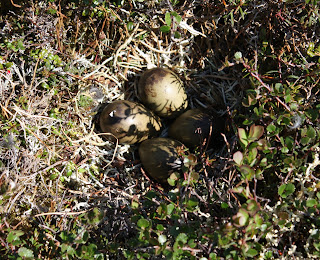While wandering across the tundra on the hunt for godwit nests we would regularly stumble across nests of other birds. Often this discovery arose following the heart-stopping flush of bird from the nest as we stepped only centimetres away. Ptarmigan often gave the most dramatic flush from the nest. Nest discoveries sometimes proved useful for other researchers in the area at the time, such as those working on Short-eared Owls or Pacific Golden Plovers. The size of a clutch would vary - all Godwit nests we found had 4 eggs, long-tailed Jaegers 2 eggs, but Ptarmigan nests typically had over 10 eggs, the largest I found had 14. There was also a variety of nest type and colouration of eggs. Here's a few examples

Ptarmigan Nest
 Godwit Nest
Godwit Nest

Short-eared Owl Nest
We were also fortunate enough to still be around as the chicks hatched. It was always a delightful sight seeing a chick bumbling its way across the tundra, in the company of the adult or hunkered down on a nest.

Short-eared Owl
Of particular interest was the fact that due to the abundance of voles and lemmings the clutches of some birds, such as Rough-legged hawks, was unusually large. In the photo below you can see a picture of a Rough-legged hawk chick, one of 6 in the nest. According to Ted Swem, a biologist who has been studying rough-legged hawks for 25 years, the typical clutch is 2-3. He had seen only two clutches of 6 in the past 25 years.


 Reindeer were a common site in the area and we were told by a local Inupiat how they would round them up using helicoptors and remove their antlers for sale to overseas markets, a valuable source of income for the indigenous communities. The Red Fox we saw were few and far between, but we did encounter depredated nests (why not predated one asks?) which could have fallen victim to a fox visit.
Reindeer were a common site in the area and we were told by a local Inupiat how they would round them up using helicoptors and remove their antlers for sale to overseas markets, a valuable source of income for the indigenous communities. The Red Fox we saw were few and far between, but we did encounter depredated nests (why not predated one asks?) which could have fallen victim to a fox visit. The Arctic ground squirrels were great little companions, popping up in all sorts of places as if to say Hi.
The Arctic ground squirrels were great little companions, popping up in all sorts of places as if to say Hi.  I love New Zealand and I love our birds, but I sometimes wish the country had evolved with a few mammals present so we could have our own encounters in the bush, as they really add to the whole experience out there. I'm not sure our introduced possums, deer & pigs cut it I'm afraid. That said, we probably wouldn't have such iconic birds like kiwi, kakapo and takahe had that been the case. I suppose it means I just have to keep travelling!
I love New Zealand and I love our birds, but I sometimes wish the country had evolved with a few mammals present so we could have our own encounters in the bush, as they really add to the whole experience out there. I'm not sure our introduced possums, deer & pigs cut it I'm afraid. That said, we probably wouldn't have such iconic birds like kiwi, kakapo and takahe had that been the case. I suppose it means I just have to keep travelling!
 However, of the ones we did catch we recorded typical data such as mass, bill length, wing length, and plumage details. We also collected feather samples to analyse for melanin content and to score the degree of wear.
However, of the ones we did catch we recorded typical data such as mass, bill length, wing length, and plumage details. We also collected feather samples to analyse for melanin content and to score the degree of wear.


 The photo above shows Jesse and I taking the net to lower over a Godwit. The photo below is of a female Godwit still on the nest, look carefully and you can see the net at the top of the photo!
The photo above shows Jesse and I taking the net to lower over a Godwit. The photo below is of a female Godwit still on the nest, look carefully and you can see the net at the top of the photo!